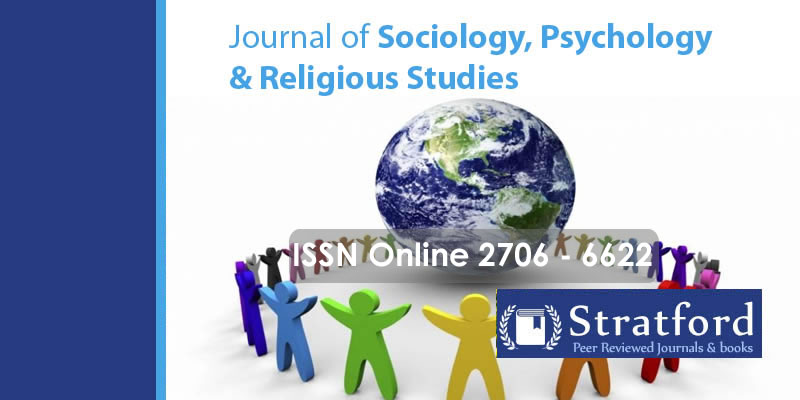The Types of Anxiety Disorders Common among Girls’ Secondary School Students in Selected Public Schools in Dagoretti North Sub-County, Kenya
Abstract
Anxiety disorders among high school students have been on the rise in the recent decade. Though anxiety disorders affect both boys and girls, studies have shown that there exist gender differences in the prevalence of anxiety. The purpose of the study was to identify the types of anxiety disorders common among girls’ secondary school students in selected public schools in Dagoretti North Sub-County, Kenya. Descriptive research design was used. The target population was 1260 girls studying in the girls’ schools in the Sub County aged between 13-18 years. A sample of 200 participants was selected using simple random sampling technique. The findings indicated that GAD, panic disorder, social anxiety disorder, separation anxiety disorder, and school avoidance were all common among secondary school students in the sampled schools. 81.5% of the respondents had at least an anxiety disorder. The study recommended that the rising levels of anxiety among secondary school students need to be addressed urgently because of the comorbidity of anxiety. Managing anxiety is most likely to lead to higher academic achievement. Secondary school students need to be psycho-educated on the self-management of anxiety.
Keywords: Types of Anxiety Disorders, Girls’ Secondary School, Public Schools
References
Andrews, B., & Wilding, J. M. (2004). The relation of depression and anxiety to life‐stress and achievement in students. British journal of psychology, 95(4), 509-521.
Bostick, D., & Anderson, R. (2009). Evaluating a small-group counseling program—A model for program planning and improvement in the elementary setting. Professional School Counseling, 12(6), 2156759X0901200602.
Chege, M., Munene, A., & Oladipo, R. (2018). African Journal of Clinical Psychology. Daystar University, 1(2), 1–10.
Costello, E.J., Copeland, W., & Angold, A. (2011). Trends in psychopathology across the adolescent years: What changes when children become adolescents, and when adolescents become adults? Journal of Child Psychology and Psychiatry, (52)10, 1015- 1025. doi: 10.1111/j.1469-7610.2011.02446.x
Cox, R. H., Martens, M. P., & Russell, W. D. (2003). Measuring anxiety in athletics: the revised competitive state anxiety inventory–2. Journal of Sport and Exercise Psychology, 25(4), 519-533.
Deb, S., Chatterjee, P., & Walsh, K. (2010). Anxiety among high school students in India: Comparisons across gender, school type, social strata and perceptions of quality time with parents. Australian Journal of educational and developmental psychology, 10, 18- 31.
Essau, C. A. (2003). Comorbidity of anxiety disorders in adolescents. Depression and anxiety, 18(1), 1-6.
Ghandour, R. M., Sherman, L. J., Vladutiu, C. J., Ali, M. M., Lynch, S. E., Bitsko, R. H., & Blumberg, S. J. (2019). Prevalence and Treatment of Depression, Anxiety, and Conduct Problems in US Children.
Glasser, W. (1965). Reality therapy. New York.
Hartmann, P. M. (2014). Anxiety. Magill’S medical guide. Retrieved from https://libproxy.lamar.edu/login url=http://search.ebscohost.com/login.aspx?direct
Khesht-Masjedi, M. F., Shokrgozar, S., Abdollahi, E., Habibi, B., Asghari, T., Ofoghi, R. S., & Pazhooman, S. (2019). The relationship between gender, age, anxiety, depression, and academic achievement among teenagers. Journal of Family Medicine and Primary Care, 8(3), 799.
Leikanger, E., Ingul, J. M., & Larsson, B. (2012). Sex and age‐related anxiety in a community sample of Norwegian adolescents. Scandinavian Journal of Psychology, 53(2), 150- 157.
Marcos‐Llinás, M., & Garau, M. J. (2009). Effects of language anxiety on three proficiency‐ level courses of Spanish as a foreign language. Foreign Language Annals, 42(1), 94- 111.
Miller, L. D., Gold, S., Laye-Gindhu, A., Martinez, Y. J., Yu, C. M., & Waechtler, V. (2011). Transporting a school-based intervention for social anxiety in Canadian adolescents. Canadian Journal of Behavioural Science/Revue canadienne des sciences du comportement, 43(4), 287.
Nelson, J. M., & Harwood, H. (2011). Learning disabilities and anxiety: A meta- analysis. Journal of learning disabilities, 44(1), 3-17.
Njagi, S. N., Migosi, J. A., & Mwania, J. M. (2014). Parental involvement, parenting style, secondary school student attitude towards schooling and academic performance in Kenya. International Journal of Education Economics and Development, 5(2), 152- 171.
Pereira, A. I., Barros, L., Mendonça, D., & Muris, P. (2014). The relationships among parental anxiety, parenting, and children’s anxiety: The mediating effects of children’s cognitive vulnerabilities. Journal of Child and Family Studies, 23(2), 399-409.
Ramagopal, G., Narasimhan, S., & Devi, L. (2016). Prevalence of depression among children living in orphanage. International Journal of Contemporary Pediatrics, 1326–1328. https://doi.org/10.18203/2349-3291.ijcp20163670
Sizoo, S., Jozkowskia, R., Malhotra, N., & Shapero, M. (2008). The effects of anxiety and self- efficacy on finance students. Journal of Instructional Psychology, 35(4), 347.
Sparks, R. L., & Ganschow, L. (2007). Is the foreign language classroom anxiety scale measuring anxiety or language skills?. Foreign Language Annals, 40(2), 260-287.
Wit, D. J. D., Karioja, K., Rye, B. J., & Shain, M. (2011). Perceptions of declining classmate and teacher support following the transition to high school: Potential correlates of increasing student mental health difficulties. Psychology in the Schools, 48(6), 556- 572.


